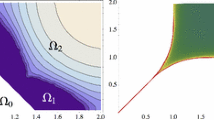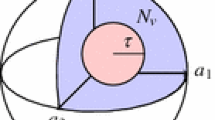Abstract
We analyze a class of discrete, univariate, and strictly quasiconcave max–min problems. A distinctive feature of max–min-type optimization problems is the nonsmoothness of the objective being maximized. Here we exploit strict quasiconcavity of the given set of functions to prove existence and uniqueness of the optimizer, and to provide computable bounds for it. The analysis inspires an efficient algorithm for computing the optimizer without having to resort to any regularization or heuristics. We prove correctness of the proposed algorithm and briefly discuss the effect of tolerances and approximate computation. Our study finds direct application in the context of certain mesh deformation methods, wherein the optimal perturbation for a vertex is computed as the solution of a max–min problem of the type we consider here. We include examples demonstrating improvement of simplicial meshes while adopting the proposed algorithm for resolution of the optimization problems involved, and use these numerical experiments to examine the performance of the algorithm.





Similar content being viewed by others
Notes
More precisely, we require the number of pairwise intersections of functions within the interval \([{\underline{\varLambda }}_{y_0},{\overline{\varLambda }}_{y_0}]\) to be finite.
We say that \(f_\alpha \) is active over the interval \({\text {I}}\) if \(F=f_\alpha \) on \({\text {I}}\).
We thank Prof. Adrian Lew (Stanford University) for helpful discussions regarding Proposition 10.
We only request that Q be defined over triangles whose vertices do not all coincide.
In general, n is less than or equal to the valence of a vertex since the quality curves of two or more elements may coincide. For the representative data in Fig. 5c, n equals the vertex valence.
References
Cherkaev, E., Cherkaev, A.: Minimax optimization problem of structural design. Comput. Struct. 86(13), 1426–1435 (2008)
Du, D., Pardalos, P.: Minimax and Applications, vol. 4. Springer, Berlin (2013)
Ke, Q., Kanade, T.: Quasiconvex optimization for robust geometric reconstruction. IEEE Trans. Pattern Anal. Mach. Intell. 29(10), 1834–1847 (2007)
Demyanov, V., Malozemov, V.: Introduction to Minimax. Dover Publications (1990).
Polyak, R.: Smooth optimization methods for minimax problems. SIAM J. Control Optim. 26(6), 1274–1286 (1988)
Xu, S.: Smoothing method for minimax problems. Comput. Optim. Appl. 20(3), 267–279 (2001)
Sotiropoulos, D.: Solving discrete minimax problems using interval arithmetic. Pac. J. Optim. 2(2), 241–259 (2006)
Wolfe, M.: On discrete minimax problems in R using interval arithmetic. Reliab. Comput. 5(4), 371–383 (1999)
Dari, E., Buscaglia, G.: Mesh optimization: how to obtain good unstructured 3D finite element meshes with not-so-good mesh generators. Struct. Optim. 8(2–3), 181–188 (1994)
Freitag, L., Jones, M., Plassmann, P.: An efficient parallel algorithm for mesh smoothing. In: Proceedings of the 4th International Meshing Roundtable, pp. 47–58 (1995)
Zavattieri, P., Dari, E., Buscaglia, G.: Optimization strategies in unstructured mesh generation. Int. J. Numer. Methods Eng. 39(12), 2055–2071 (1996)
Bank, R., Smith, R.: Mesh smoothing using a posteriori error estimates. SIAM J. Numer. Anal. 34(3), 979–997 (1997)
Alliez, P., Ucelli, G., Gotsman, C., Attene, M.: Recent advances in remeshing of surfaces. In: De Floriani, L., Spangnuolo, M. (eds.) Shape Analysis and Structuring, pp. 53–82. Springer, Berlin (2008)
Amenta, N., Bern, M., Eppstein, D.: Optimal point placement for mesh smoothing. J. of Algorithms 30(2), 302–322 (1999)
Eppstein, D.: Quasiconvex programming. Comb. Comput. Geom. 52, 287–331 (2005)
Ansari, Q., Lalitha, C., Mehta, M.: Generalized Convexity, Nonsmooth Variational Inequalities, and Nonsmooth Optimization. CRC Press, Boca Raton (2013)
Greenberg, H., Pierskalla, W.: A review of quasi-convex functions. Oper. Res. 19(7), 1553–1570 (1971)
Rangarajan, R., Lew, A.: Provably robust directional vertex relaxation for geometric mesh optimization (submitted, 2016)
Knupp, P.: Algebraic mesh quality metrics. SIAM J. Sci. Comput. 23(1), 193–218 (2001)
Pébay, P., Baker, T.: Analysis of triangle quality measures. Math. Comput. 72(244), 1817–1839 (2003)
Frey, W., Field, D.: Mesh relaxation: a new technique for improving triangulations. Int. J. Numer. Methods Eng. 31(6), 1121–1133 (1991)
Du, Q., Wang, D., Zhu, L.: On mesh geometry and stiffness matrix conditioning for general finite element spaces. SIAM J. Numer. Anal. 47(2), 1421–1444 (2009)
Liu, A., Joe, B.: On the shape of tetrahedra from bisection. Math. Comput. 63(207), 141–154 (1994)
Barber, B., Dobkin, D., Huhdanpaa, H.: The quickhull algorithm for convex hulls. ACM Trans. Math. Softw. 22(4), 469–483 (1996)
Kobel, A., Rouillier, F., Sagraloff, M.: Computing real roots of real polynomials... and now for real! arXiv preprint arXiv:1605.00410 (2016)
Edelman, A., Murakami, H.: Polynomial roots from companion matrix eigenvalues. Math. Comput. 64(210), 763–776 (1995)
Galassi, M., Davies, J., Theiler, J., Gough, B., Jungman, G., Alken, P., Booth, M., Rossi, F.: GNU scientific library reference manual. URL http://www.gnu.org/software/gsl, version 1 (2010)
Author information
Authors and Affiliations
Corresponding author
Rights and permissions
About this article
Cite this article
Rangarajan, R. On the resolution of certain discrete univariate max–min problems. Comput Optim Appl 68, 163–192 (2017). https://doi.org/10.1007/s10589-017-9903-z
Received:
Published:
Issue Date:
DOI: https://doi.org/10.1007/s10589-017-9903-z
Keywords
- Discrete minimax
- Quasiconvex optimization
- Nonsmooth optimization
- Mesh optimization
- Mesh smoothing
- Polynomial roots




